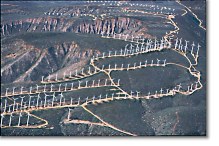You are herePalm Springs - Flying There
Palm Springs - Flying There
| Pilot Getaways - Palm Springs | |
Flying There |
|
At an elevation of 462 feet, Palm Springs lies at the base of 10,831-ft. Mt. San Jacinto and only a few miles from the 11,499-ft. peak of San Gorgonio. These steep mountains provide a stunning backdrop from anywhere in the city, but can also create substantial turbulence. If it's windy at Palm Springs, remain on the east side of Highway 111, away from high terrain. Your passengers will thank you for a smoother ride.
Most aircraft approaching Palm Springs from the West will fly through the Banning Pass. A good waypoint to navigate to is BNG, Banning Airport, in the middle of the pass. The numerous windmills in the pass are a clear indication of how windy it becomes here. Even when Southern California winds are moderate, the pass funnels winds, amplifying them as a result of the Venturi Effect.
Expect stronger winds in the Banning Pass than indicated in Winds Aloft Forecasts, and be prepared for strong up- and downdrafts. Try to stay on the downwind side of the pass (where the updrafts are) rather than on the upwind side (where the downdrafts are).


It may be difficult to determine the "upwind" or "downwind" side of the pass, since the wind is usually blowing through the pass, almost parallel to the ridges. Under normal conditions, winds are out of the Southwest, favoring flight through the north side of the pass. During Santa Ana conditions, winds are usually out of the North, favoring flight through the south side of the pass.
If you're arriving from the Northeast, the FAA recommends 2,000-ft terrain clearance over the Joshua Tree National Monument. A cruising altitude of 8,500 feet should suffice. Approaching from the Southeast, you'll fly over the Salton Sea - California's largest lake and one of the few bodies of water below sea level (elevation is -230 feet).
Palm Springs is one of the few remaining Terminal Radar Service Areas (TRSAs) in the United States. Radar separation is provided between participating VFR aircraft and IFR aircraft operating in the TRSA. TRSA services are similar to those provided in Class C airspace, with the exception that participation is voluntary for VFR pilots. We strongly recommend use of TRSA services any time they are available.
Contact Palm Springs Approach with your position and intentions while still outside the TRSA, indicated by a magenta border on the Los Angeles Sectional Chart. If you're approaching from the West, you should be able to contact Palm Springs Approach from over the Banning Airport. Palm Springs has a remote transmitter site north of the airport, so communications are possible well into the Banning Pass, out of line-of-sight range from the airport. From the East, communications are possible at much greater distances, since there is no intervening high terrain.
Before departure, contact Palm Springs clearance delivery and advise them of your VFR route and requested cruising altitude. They will then assign a squawk code and departure routing.
Two FBOs are available to visiting pilots: AMR Combs and Signature Aviation. Both are full service FBOs that provide everything from a few gallons of 100LL for your Cessna 150 to complete catering and ramp services for your Gulfstream. We liked the swimming pool, Jacuzzi, and free cookies for pilots at Signature Aviation, on the east side of the field. The complimentary courtesy car (subject to availability) and convenient location just north of the main terminal on the west side of the field also make AMR Combs very attractive. The rates for both FBOs are comparable.
=> history
Main Article: Palm Springs

Page 1 ............... Main Page / Intro
Sidebar: The Historic Hotels of Old Palm Springs
Page 3 ............... History
Page 4 ............... What to Do
Page 5 ............... Where to Stay
Page 6 ............... Where to Eat
Page 7 ............... Transportation
Page 1 .............. Intro
Back to Pilot Getaways Home Page
Page 2 .............. North African Nights
Page 3 .............. Movie Stars' Hideaway
Page 4 .............. A B&B Country Inn with a French Flair

